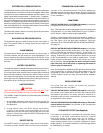
5
At times you may not be able to smell an LP gas leak. One cause
is odor fade, which is a loss of the chemical odorant that gives LP
gas its distinctive smell. Another cause can be your physical
condition, such as having a cold or diminishing sense of smell with
age. For these reasons, the use of a propane gas detector is
recommended. IF YOU EXPERIENCE AN OUT OF GAS
SITUATION, DO NOT TRY TO RELIGHT APPLIANCES YOURSELF.
Call your local service agent. Only trained LP professionals should
conduct the required safety checks in accordance with industry
standards.
HIGH ALTITUDE INSTALLATION
WARNING
INSTALLATIONS ABOVE 4,500 FEET REQUIRE REPLACEMENT
OF THE BURNER ORIFICES. FAILURE TO REPLACE THE
ORIFICES WILL RESULT IN IMPROPER AND INEFFICIENT
OPERATION OF THE APPLIANCE, PRODUCING CARBON
MONOXIDE GAS IN EXCESS OF SAFE LIMITS, WHICH COULD
RESULT IN SERIOUS PERSONAL INJURY OR DEATH.
GENESIS BOILERS ARE EQUIPPED WITH SELF-REGULATING
PREJET ORIFICES WHICH AUTOMATICALLY COMPENSATE FOR
HIGHER ELEVATIONS AND ADJUST THE APPLIANCE'S INPUT
RATE ACCORDINGLY, MAKING IT UNNECESSARY TO REPLACE
ORIFICES FOR HIGH ALTITUDE (UP TO 4,500 FEET). CONSULT
THE FACTORY FOR HIGHER ALTITUDES.
Some utility companies derate their gas for altitude. You should
contact your gas supplier for any specific changes which may be
required in your area. Call the local gas utility to verify BTU content
of the gas supplied.
Input rating specified on the rating plate applies to elevations up to
4,500 feet (1350 m). For elevations above 4,500 feet (1350 m),
ratings must be reduced, consult the factory.
FEATURES/CONTROLS
MULTI-STAGE FIRING AND CONTROL SYSTEM
ALL MODELS - The control system consists of four basic
components: 1) Central Control Board 2) Flame Control Board 3)
User Interface Module 4) Power Distribution Board; see Figures
17, 18, 19 and 21. The Central Control Board, Flame Control
Boards and the Power Distribution Board are located in the
control box and can be accessed through panels on the left side
and top of the unit. The User Interface Module is attached to the
front jacket panel. The control system is a multi-stage control
capable of managing three or four firing stages. Models 1000,
1300, and 1500 operates with 3-stage fire. Models 1850, 2100
and 2500 operates with 4-stage fire. Every system will have one
Central Control Board (CCB), one Power Distribution Board
(PDB), one User Interface Module (UIM) and either two or three
Flame Control Boards (FCB) depending on the model.
The Control Boards Figure 17 and 18, contain dipswitches which
allow the user to control several system options. See Control System
Section.
GROUNDING INSTRUCTIONS
This boiler must be grounded in accordance with the National
Electrical Code, NFPA 70 or the Canadian Electrical Code CSA 2
C22.1
and/or local codes. The boiler is polarity sensitive, correct
wiring is imperative for proper operation.
This boiler must be connected to a grounded metal, permanent wiring
system, or an equipment grounding conductor must be run with the
circuit conductors and connected to the equipment grounding
terminal or lead on the boiler.
WARNING
YOUR BOILER IS NOT DESIGNED TO OPERATE WITH A BOILER
INLET WATER TEMPERATURE OF LESS THAN 120°F (49°C).
COLDER INLET WATER TEMPERATURE WILL RESULT IN
SIGNIFICANT CONDENSATION DEVELOPING ON THE HEAT
EXCHANGER. THIS SITUATION CAN CAUSE A CORROSIVE
ENVIRONMENT FOR THE HEAT EXCHANGER, BURNERS AND
VENTING RESULTING IN PREMATURE DAMAGE, WHICH COULD
RESULT IN SERIOUS PERSONAL INJURY OR DEATH.
FOR SYSTEMS THAT USE LARGE VOLUMES OF COLD WATER
OR SYSTEMS UTILIZING HEAVY WATER DRAWS, CONDENSATION
CAN BE PREVENTED BY USING A BYPASS LOOP.
CORRECT GAS
Make sure the gas on which the boiler will operate is the same as
that specified on the boiler rating plate. Do not install the boiler if
equipped for a different type of gas, consult your gas supplier.
PRECAUTIONS
IF THE UNIT IS EXPOSED TO THE FOLLOWING, DO NOT
OPERATE UNTIL ALL CORRECTIVE STEPS HAVE BEEN MADE BY
A QUALIFIED SERVICEMAN:
1. EXPOSURE TO FIRE.
2. IF DAMAGED.
3. FIRING WITHOUT WATER.
4. SOOTING.
IF THE BOILER HAS BEEN EXPOSED TO FLOODING, IT MUST BE
REPLACED.
LIQUID PETROLEUM MODELS
Boilers for propane or liquefied petroleum gas (LPG) are different
from natural gas models. A natural gas boiler will not function
safely on LP gas and no attempt should be made to convert a
boiler from natural gas to LP gas.
LP gas must be used with great caution. It is highly explosive and
heavier than air. It collects first in the low areas making its odor
difficult to detect at nose level. If LP gas is present or even suspected,
do not attempt to find the cause yourself. Leave the building, leaving
doors open to ventilate, then call your gas supplier or service agent.
Keep area clear until a service call has been made.


















